Victoria Sadler's Blog, page 17
July 20, 2014
Radical Geometry: Sensational South American Art at Royal Academy
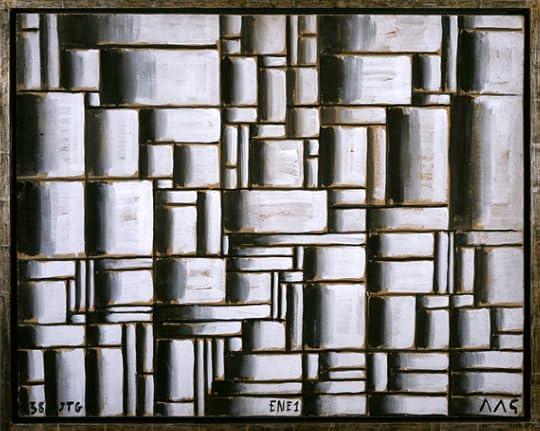
Whatever preconceived ideas you have on 20th Century South American art, prepare to have them thrown out the window in this sensational exhibition at the Royal Academy.
Emboldened by the optimism that swept the continent in the 1930s, when regional economies were booming and liberal politics were in the ascendancy, distinct groups of artists emerged that rejected figurative art, so dominant in Europe, in favour of an industrial, geometric approach.
On his return from trips across Europe, Torres-Garcia led the way by merging avant-garde approaches with pre-Colombian images to create a uniquely South American style. However this combination of the old and new was quickly seen as anachronistic by new artists coming through who preferred a neo-revolutionary attitude.
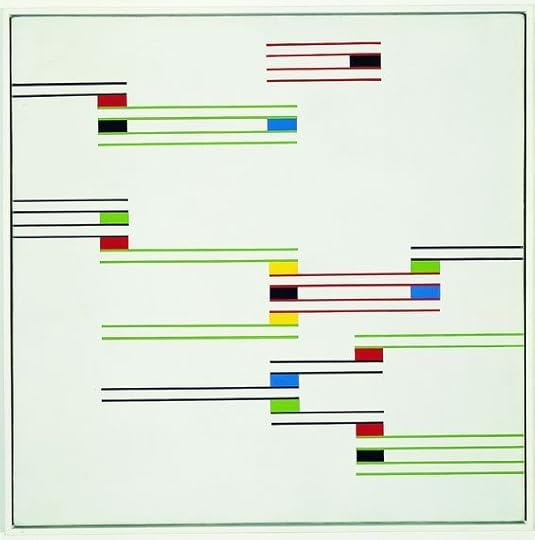
For new artists such as Carmelo Arden Quin, Gyula Kosice and Juan Melé, art was seen as a fundamental component of social revolution and so embraced reactive and experimental approaches. The result was this radical geometric style, often painstakingly created by hand.
A fascinating piece of work in the first room is Gyula Kosice's Mobile Articulated Sculpture (1948), small, thin pieces of brass fastened together in a loose chain. A deliberately interactive work, the piece has no form or purpose until it is manipulated by the viewer into various shapes.
Only you're not allowed to touch it.
I asked but a got a very strict, 'No. The owner is here from New York and they said, No.' A sad reflection of where the value is in art these days - in its financial worth rather than its cultural impact. I desperately wanted to mould and play with the piece but instead I had to make do with a video of the artist alongside showing how it's done.
But that was the only downer in what is such an exciting exhibition.
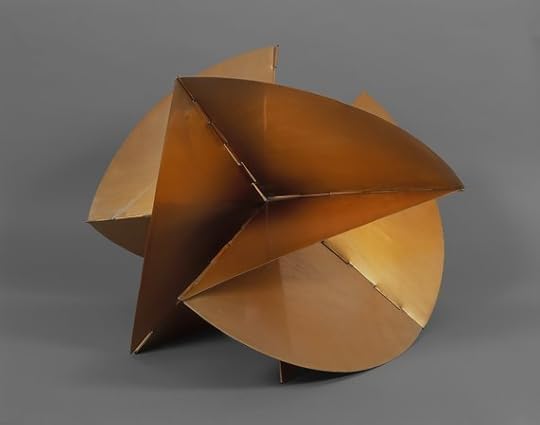
The sculptural works are, for me, the highlight of the exhibition, and make up most of the second room including a number of works from Willys de Castro. His Active Object (red/white cube) attached high on the wall is a great piece.
The sculptures from Lygia Clark are also wonderful, in particular her Machine pieces - sheets of silver or gold aluminium crumpled up like origami, which were a rejection of not just conventional sculpture but also the industrial aesthetic and mathematical principles that dominated work from other artists in Brazil.
My favourite piece of work on show dominates the third room, which focuses on Venezuelan artists.
Jesus Soto's Nylon Cube comprises hundreds of taut nylon strings connected to two large white blocks, one fastened to the ceiling, the other to the floor. Each string is partly dyed in blue ink and the visual effect is incredible. As you peer at and through the strings, your perception is altered and muddled. Wonderful.
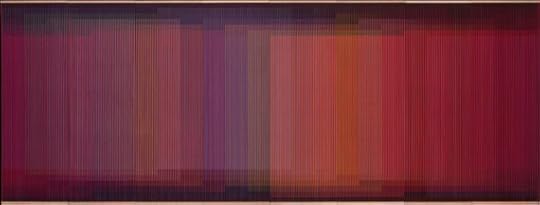
Also a highlight is the final piece in the exhibition, Carlos Cruz-Diez's Physichromie No. 500. The picture does not do this great piece of art justice. This stunning Casein paint on PVC and acrylic on plywood sheets seems gloss red but as you pass in front of the piece, you can see yellow and greens burst through from the back of this three-dimensional piece of work.
The exhibition is superbly curated by Adrian Locke and Gabriel Perez-Barrei. The subject matter is not a well-known one and the information boards in each of the rooms give great introductions and insight into the region, its politics and the impact on the artistic groups that formed and flourished.
The Summer Exhibition and Dennis Hopper's photography are the big draws at the Royal Academy but this exhibition absolutely blew me away. The art was stunning - so vibrant and unexpected. Whatever you're expecting, prepare for the unexpected.
Royal Academy of Arts, London to September 28, 2014
Image Credits:
1. Joaquin Torres-Garcia Construction in White and Black, 1938 Oil on paper mounted on wood, 80.7 x 101.9 cm The Museum of Modern Art, New York. Gift of Patricia Phelps de Cisneros in honour of David Rockefeller, 2004. Photo Coleccion Patricia Phelps de Cisneros
2. Lygia Clark Machine â?? Medium, 1962 Golden aluminum, approx. 48.2 x 66.1 x 61 cm Coleccion Patricia Phelps de Cisneros c. The World of Lygia Clark Cultural Association
3. Alfredo Hlito Chromatic Rhythms II, 1947 Oil on canvas, 69.9 x 70.2 cm Coleccion Patricia Phelps de Cisneros c. Sonia Henriquez Urena de Hlito
4. Carlos Cruz-Diez Physichromie No. 500, 1970 Casein paint on PVC and acrylic on plywood sheets, 183 x 484 x 8 cm Coleccion Patricia Phelps de Cisneros c. ADAGP, Paris and DACS, London 2014.
Published on July 20, 2014 09:41
July 16, 2014
Review: Richard Armitage in The Crucible, Old Vic Theatre
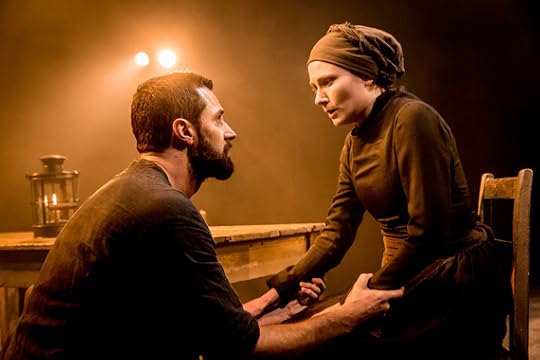
Our former Education Secretary Michael Gove may not have liked it on our syllabus but The Crucible remains one of the most important and influential plays of the twentieth century. Arthur Miller's tale of religious hysteria in the Salem witch trials of 1692 is a masterpiece of profound social and political commentary mixed beautifully with human emotions and relationships on a small, interpersonal level.
Directed by Yaël Farber, this production at the Old Vic balances the madness with moments of real tenderness and poignancy, driving up all the emotions necessary for this play to succeed - anger at the injustice, sadness for those who lose all they have and heartbreak for those who face their deaths with the one thing they have left, honour.
At the heart of this production is an immense performance from Richard Armitage who perfectly captures the profound inner conflict within John Proctor, a man increasingly at odds with both his wife and the society in which he lives.
Armitage has such a wonderfully deep, rich voice that brings authority to his character but as an instrument, his voice really takes the strain as his character runs the gamut of emotions as his life unravels at the hands of Abigail, a young girl he has a brief affair with and who takes her revenge by whipping up accusations of witchcraft throughout Salem. One can only hope Armitage's voice holds up for the whole run.
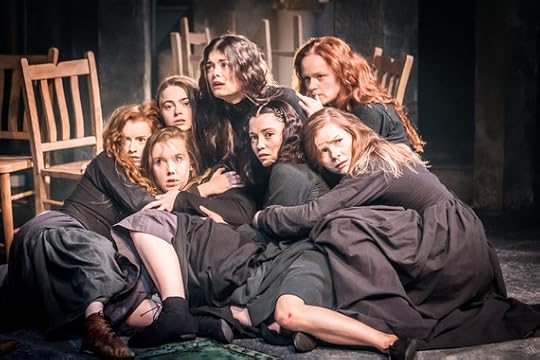
Creating hysteria on stage can be tricky, with the high risk that it can tip over into overwrought acting. A couple of performances fall on the wrong side of that fine line (though, interestingly, not from any of the young women) but they are balanced out by some excellent performances elsewhere in the cast.
Anna Madeley as John Proctor's wife Elizabeth gives a performance of great restraint as the dutiful wife trying hard to reconcile herself with her husband's infidelity. Adrian Schiller is also superb as Reverend John Hale, a man struggling to come to terms with the increasing injustice in the trials that he had, at first, been only too keen to start.
But the real star of the show remains Arthur Miller's writing. What's interesting, 50 years on after McCarthyism, is how this play speaks to us about so much more than anti-communist hysteria. We live in a world of increasing fear about religious fundamentalism - whether that by Muslim, Jewish or Christian - and this play serves as a warning on how profound religious loyalty can be manipulated by those seeking to serve their own ends.
But more than the political, through John and Elizabeth, Miller captures a broken relationship where trust has gone but love and duty remains. The two scenes between husband and wife - before the trial and after - are the tenderest scenes in the play and really give it its heart.
However Miller might not readily be described as much of a feminist and I wince still as Elizabeth takes a lot of the blame for her husband's infidelity because she "kept a cold house."
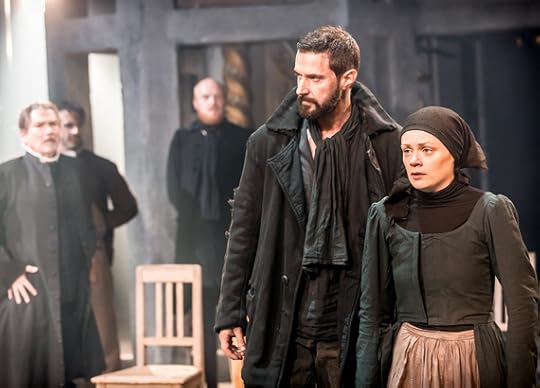
The cast is ably served by a stark set from Soutra Gilmour, the very talented designer also responsible for the very busy 1970s set in Jamie Lloyd's Richard III. The minimal set here though could not be more different.
With the stage in the round, the stripped floorboards, wooden chairs and rusty bedframes not only reflect the impoverished condition of the Salem community but give the cast much room in which to whip up the mania, with some impressive choreographed movement from the young girls in thrall to the rejected, volatile and dangerously charismatic Abigail (a passionate performance from Samantha Colley).
Much has been said about the play's running time - it comes in at three and a half hours. I had seriously doubted those who had seen the show and said that the time just flew by but really, it did. I was completely enwrapped in this very dramatic but also moving production.
Accompanying me to the show was a grandma and an 11 year old girl, neither of whom were that familiar with the text. Both of them though were completely engrossed in the play and distraught with the injustice of the story. The power of Miller's writing lives on.
Old Vic Theatre, London to September 13, 2014
Image Credits:
1. Richard Armitage (John Proctor) and Anna Madeley (Elizabeth Proctor) photo credit Johan Persson
2. The Crucible Cast photo credit Johan Persson
3. Richard Armitage (John Proctor) and Natalie Gavin (Mary Warren) photo credit Johan Persson
Victoria's debut novel Banking on Burlesque is available now.
Published on July 16, 2014 14:14
July 12, 2014
Review: Martin Freeman in Richard III, Trafalgar Studios
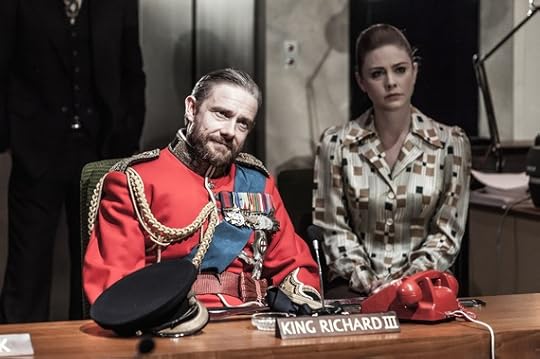
There is much that is exciting and innovative about Jamie Lloyd's Richard III at Trafalgar Studios but though it bristles with energy and interesting ideas, for me, it is good rather than great.
Richard III, with the possible exception of Iago, may well be Shakespeare's greatest villain. But unlike Othello's antagonist, Richard, Duke of Gloucester, shares plenty of droll and darkly comical moments with us as he navigates his bloody path to the throne.
Director Jamie Lloyd obviously enjoys the opportunity to reinterpret Shakespeare as, much like his Macbeth with James McAvoy from last year, this play has been brought out of its historical setting in favour of something more current - in this instance, Britain in the late 1970s.
It's a decision that's an obvious nod to the famous opening line "Now is the winter of our discontent." It's an interesting choice but this decision doesn't ever seem to amount to much more than clever word play.
The premise seems to be that, as a response to the country's profound industrial and economic woes, the military has taken over and set up base on an open-plan office floor in a high-rise building. It's a stretch that I wouldn't have minded - I love it when Shakespeare is reimagined - but it was unclear what this setting brought to the production in terms of observation or social commentary.
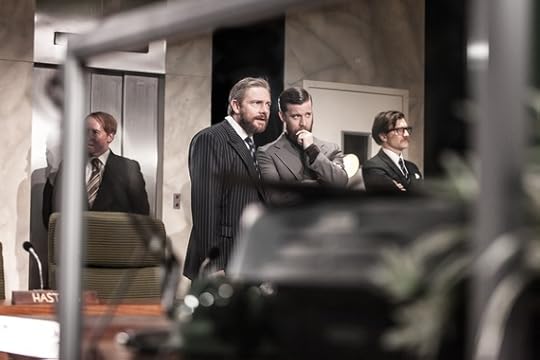
And as the play progressed, the setting seemed to create a bit of tangled web as it became harder to shoehorn parts of the play in, such as the Battle of Bosworth. Here, the battle is reinterpreted as a raid on the military compound from an elite force armed to the teeth with machine guns but that, in turn, reduces "a horse, a horse, my kingdom for a horse" to an odd ironic comment.
Yet, having said that, once you let that go, there is much to enjoy with some fine achievements from cast and creative alike.
The set from award-winning designer Soutra Gilmour is wonderful. At first glance, a stage crammed full of desks, televisions, boardroom tables, office telephones and fish tanks seems to offer its cast obstacles rather than opportunities but with some nifty directing and splendid movement from the cast, it morphs into a perfect battleground as desk partitions become walls to cower behind and boardroom tables become battle lines.
And when this is punctuated with touches such as tedious elevator music and executive toys, it lends the atmosphere a wonderful sense of the bizarre that may seem strange, but is actually in perfect keeping with the world being created.
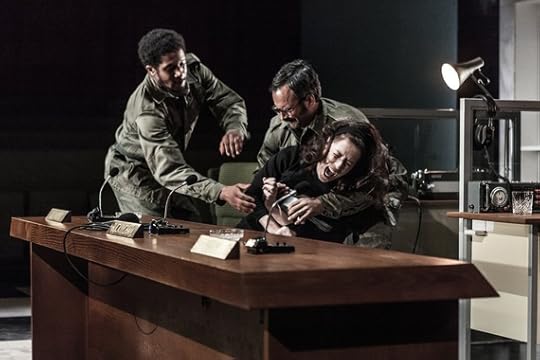
The acting from the whole cast is strong. I particularly enjoyed Gina McKee who brought real fire and rage to her distressed and cornered Queen Elizabeth. The box-office draw though is, of course, Martin Freeman as the wicked King-to-be.
Martin Freeman has a well-deserved reputation for interesting approaches to text and impeccable comic timing and both those talents are well-used here. He has a great knack for using pauses for dramatic effect and sources of humour, such as when he's asked to address the nobles, all of whom he will of course murder on his way to the top, the disdain is palpable as he starts "Amongst this princely...heap."
Freeman's Richard has a warm, charming veneer to his callous and ruthless heart. But I didn't sense much in the way of real indulgence or revelry in his villainy. And there was no hint of any sexual charisma in his wooing of Lady Anne. Instead Freeman goes for the pity angle, to try to get Anne to feel sorry for him.
I guess it comes down to how you like your Richard III. I prefer mine to be brooding with conspiracy and charisma, for me to be sickened and amused by him in equal measure. After all, when that fourth wall comes down, I like being made to feel as if we're co-conspirators in his heinous crimes - only to be sickened with how far Richard goes.
Freeman's Richard seems more distant from the crimes he demands others commit on his behalf. When Lord Hastings' head is brought to him in a box, Freeman turns away, flinching at the bloodied head when I'm looking for my Richard to be completely unfazed, even to stick his hands in the box to make sure the right guy has been killed.
Much effort is made to ensure newcomers stay on top of the plotting with planned victims spot lit on stage and key plot points sign-posted. In that way, this show works hard to get new audiences (and old!) excited about Shakespeare and about theatre. Not all of this production works and it's unlikely to be remembered as a one of the great versions of this wonderful play, but it's an enjoyable evening nonetheless.
Trafalgar Studios, London to September 27, 2014
Image credits:
1. Richard III - Martin Freeman and Lauren O'Neil - Photo Marc Brenner
2. Richard III - L-R - Forbes Masson Martin Freeman Philip Cumbus Jo Stone-Fewings - Photo Marc Brenner
3. Richard III - L- R - Simon Coombs Gerald Kyd and Gina McKee - Photo Marc Brenner
Published on July 12, 2014 02:34
July 9, 2014
Are You a Woman? Are You Writing a Memoir? Great, Read This!
The popularity of women's memoirs is booming. Women from all walks of life are finding that memoirs are a way of communicating, shedding light on experiences that would go unnoticed, hidden in a world dominated by men and male preferences.
Orange is the New Black, a memoir Piper Kerman wrote about her year in a woman's prison is not only a best-selling book but now one of the biggest shows on television. As is Call the Midwife, Jennifer Worth's memoir about her life as a young midwife in post-war London.
And we may have sadly lost Maya Angelou but how heart-warming it is to see A Caged Bird Sings, Angelou's memoir on overcoming childhood abuse and trauma, storm up the best-seller list again.
Memoirs can also be controversial. But as Amanda Knox and Samantha Geimar, authors of respective memoirs Waiting to be Heard and The Girl: A Life in the Shadow of Roman Polanski, will tell you, memoirs give women a platform to be heard in their own words away from lurid headlines.
Not only do memoirs bring out a whole world of unheard stories but writing one can also start a new career. Author Polly Courtney has now published a further six books since starting with her memoir of life in The City in Golden Handcuffs. And it's a path I hope to follow as my own memoir Banking on Burlesque, was published last year.
Like all good memoirs my story focuses on an unusual experience - that of a female investment banker thrown out for her secret hobby as a burlesque performer - and set in worlds that people are curious about - banking and burlesque.
But more than that, memoirs resonate because of the shared emotive experiences. So though my story may be unusual, if not unique, readers can relate because of common themes for everyone, such as finding a way to live rather than exist, the expression and censorship around female sensuality, as well as institutionalised sexism.
In recognition that there are so many more stories from women that deserve to be heard, the women's writing magazine Mslexia has dedicated its annual novel competition to memoirs only.
If this is something you want to do, great! But remember that a memoir is not an autobiography. It is not an entire life history, rather a focus on an event or period in life that is unusual, exceptional and that would, for all intents and purposes, make for a great story - with the exceptional fact that this story is true.
And when I say 'true', don't feel trapped into thinking that every word you write in a memoir must be the literal truth. Not at all. Memoirs are shaped to fit a story arc and between the covers of a book. For example, my memoir condensed an eight-year period into 90,000 words so editing was absolutely necessary!
But also the truth of any memoir is only ever going to be your truth. I'm sure other people who've witnessed your events in your life would describe them another way. And that's ok. It's your own truth, how you saw them and how they impacted you that people want to connect with.
As a result, there's a temptation to think that memoirs are easy to write. I mean, you've just got to regurgitate what you remember, right? No. Please don't think that! Not only does the literal truth require examination in order to make it interesting but the process of writing a memoir can be difficult.
My book was about the best of times and the worst of times in my life. That meant reliving again and again a period of my life that maybe I'd rather have chosen to forget. My decision also came with consequences - investment banks don't exactly respond well to former employees publishing their experiences!
But more than this, memoir writing requires an examination of yourself.
An interesting main character has faults, contradictions and even truly horrible personality traits. How prepared are you to make yourself ugly on the page?
Like me, you may want to write about a situation where you were the victim but be careful. This set-up can lead you to romanticise yourself, to portray yourself as a perfectly wonderful person that had no faults yet suffered a terrible injustice.
We are all complicated beings and we respond to seeing that complication reflected back at us. So when you hold up that mirror to yourself, write the bad as well as the good. And have strength that displaying your flaws will not detract from sympathy for you. It won't. Quite the opposite - it will show that you're human.
Also beware of using a memoir to vent frustrations. I have sympathy for this knee-jerk reaction, I really do. My first draft of Banking on Burlesque suffered with this very issue. It actually took me a few years from my first to final draft to complete as I needed to create emotional distance between myself and the events I was writing about. Time heals wounds - and also improves writing.
Having said all this, please don't feel daunted or put-off from writing a memoir. If you have a story to tell, tell it! Who's to say that your story, your own experience isn't just what we're all waiting to hear?
Mslexia has also created some online workshops to help you get the most out of your ideas on such crucial areas such as 'finding your voice' and building the skeleton of your story. So why not enter? What more can I say to persuade you?
Well, if you think writing is something you want to pursue long-term, being shortlisted in the competition will put your novel at the top of any agent's or editor's in-tray. Rosie Garland, winner of Mslexia's inaugural Women's Novel Competition in 2011, signed a six-figure deal with HarperCollins soon after winning the competition.
Plus 12 shortlisted authors will be invited to a networking event and introduced to a specially invited group of literary agents. The three finalists will also each received detailed feedback on their manuscript from The Literary Consultancy. And feedback really is crucial for all of us wanting to develop a new career.
And the winner? Well, they'll receive £5,000 - need I say more?!
Submissions need to be the first 5,000 words of a full-length memoir, written in prose, and narrate actual events in your life. Have a look on the website here. And good luck!
Victoria's debut novel Banking on Burlesque is now available on Amazon as well as iBooks and all good online retailers.
Orange is the New Black, a memoir Piper Kerman wrote about her year in a woman's prison is not only a best-selling book but now one of the biggest shows on television. As is Call the Midwife, Jennifer Worth's memoir about her life as a young midwife in post-war London.
And we may have sadly lost Maya Angelou but how heart-warming it is to see A Caged Bird Sings, Angelou's memoir on overcoming childhood abuse and trauma, storm up the best-seller list again.
Memoirs can also be controversial. But as Amanda Knox and Samantha Geimar, authors of respective memoirs Waiting to be Heard and The Girl: A Life in the Shadow of Roman Polanski, will tell you, memoirs give women a platform to be heard in their own words away from lurid headlines.
Not only do memoirs bring out a whole world of unheard stories but writing one can also start a new career. Author Polly Courtney has now published a further six books since starting with her memoir of life in The City in Golden Handcuffs. And it's a path I hope to follow as my own memoir Banking on Burlesque, was published last year.
Like all good memoirs my story focuses on an unusual experience - that of a female investment banker thrown out for her secret hobby as a burlesque performer - and set in worlds that people are curious about - banking and burlesque.
But more than that, memoirs resonate because of the shared emotive experiences. So though my story may be unusual, if not unique, readers can relate because of common themes for everyone, such as finding a way to live rather than exist, the expression and censorship around female sensuality, as well as institutionalised sexism.
In recognition that there are so many more stories from women that deserve to be heard, the women's writing magazine Mslexia has dedicated its annual novel competition to memoirs only.
If this is something you want to do, great! But remember that a memoir is not an autobiography. It is not an entire life history, rather a focus on an event or period in life that is unusual, exceptional and that would, for all intents and purposes, make for a great story - with the exceptional fact that this story is true.
And when I say 'true', don't feel trapped into thinking that every word you write in a memoir must be the literal truth. Not at all. Memoirs are shaped to fit a story arc and between the covers of a book. For example, my memoir condensed an eight-year period into 90,000 words so editing was absolutely necessary!
But also the truth of any memoir is only ever going to be your truth. I'm sure other people who've witnessed your events in your life would describe them another way. And that's ok. It's your own truth, how you saw them and how they impacted you that people want to connect with.
As a result, there's a temptation to think that memoirs are easy to write. I mean, you've just got to regurgitate what you remember, right? No. Please don't think that! Not only does the literal truth require examination in order to make it interesting but the process of writing a memoir can be difficult.
My book was about the best of times and the worst of times in my life. That meant reliving again and again a period of my life that maybe I'd rather have chosen to forget. My decision also came with consequences - investment banks don't exactly respond well to former employees publishing their experiences!
But more than this, memoir writing requires an examination of yourself.
An interesting main character has faults, contradictions and even truly horrible personality traits. How prepared are you to make yourself ugly on the page?
Like me, you may want to write about a situation where you were the victim but be careful. This set-up can lead you to romanticise yourself, to portray yourself as a perfectly wonderful person that had no faults yet suffered a terrible injustice.
We are all complicated beings and we respond to seeing that complication reflected back at us. So when you hold up that mirror to yourself, write the bad as well as the good. And have strength that displaying your flaws will not detract from sympathy for you. It won't. Quite the opposite - it will show that you're human.
Also beware of using a memoir to vent frustrations. I have sympathy for this knee-jerk reaction, I really do. My first draft of Banking on Burlesque suffered with this very issue. It actually took me a few years from my first to final draft to complete as I needed to create emotional distance between myself and the events I was writing about. Time heals wounds - and also improves writing.
Having said all this, please don't feel daunted or put-off from writing a memoir. If you have a story to tell, tell it! Who's to say that your story, your own experience isn't just what we're all waiting to hear?
Mslexia has also created some online workshops to help you get the most out of your ideas on such crucial areas such as 'finding your voice' and building the skeleton of your story. So why not enter? What more can I say to persuade you?
Well, if you think writing is something you want to pursue long-term, being shortlisted in the competition will put your novel at the top of any agent's or editor's in-tray. Rosie Garland, winner of Mslexia's inaugural Women's Novel Competition in 2011, signed a six-figure deal with HarperCollins soon after winning the competition.
Plus 12 shortlisted authors will be invited to a networking event and introduced to a specially invited group of literary agents. The three finalists will also each received detailed feedback on their manuscript from The Literary Consultancy. And feedback really is crucial for all of us wanting to develop a new career.
And the winner? Well, they'll receive £5,000 - need I say more?!
Submissions need to be the first 5,000 words of a full-length memoir, written in prose, and narrate actual events in your life. Have a look on the website here. And good luck!
Victoria's debut novel Banking on Burlesque is now available on Amazon as well as iBooks and all good online retailers.
Published on July 09, 2014 14:07
July 5, 2014
Dennis Hopper: Actor, Director, Firestarter and Photographer
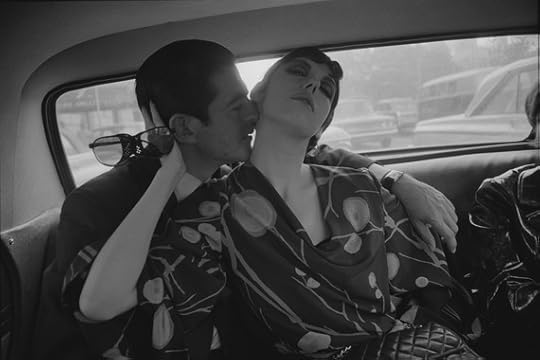
Dennis Hopper is probably as well-known for his reputation as a hellraiser as he is for his acting and filmmaking. But he was also a wonderfully talented photographer and it's this talent that is the focus of this revealing and surprisingly emotive exhibition at the Royal Academy.
Hopper was never formally trained as an artist though he had created paintings and assemblages throughout his career. It was James Dean who fostered his interest in photography so when Hopper found himself blacklisted by Hollywood in 1961, he turned to photography as his main creative outlet.
And from these inauspicious starts, Hopper's outlet became almost obsessive with him taking about 18,000 photographs between 1961 and 1967.
In this exhibition, the Royal Academy presents more than 400 original photographs taken during these years. The photographs had been personally selected and edited by Hopper for his first major exhibition at the Fort Worth Art Center, Texas in 1970 but this is the first time this body of work has been seen in the UK.
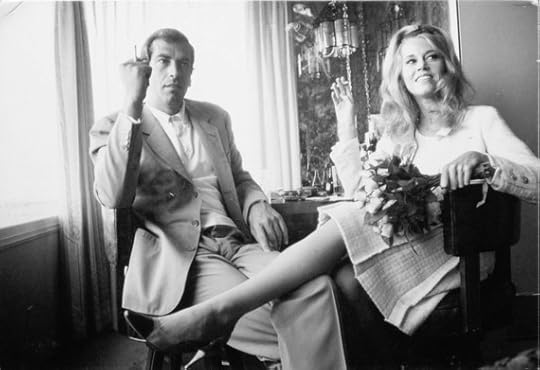
The range of subject matter reflects Hopper's broad interests with pictures of both the glamorous and the everyday. At times playful, at other times political, this collection of photographs also reflects America's dynamic social and cultural life in the 1960s.
There are plenty of photographs of the familiar with iconic portraits of Paul Newman, Ike and Tina Turner, Jane Fonda, Phil Spector and Brian Jones. But Hopper had a great ability to earn the trust of a wide range of communities, enabling him to reflect a broad demographic in his work.
Shots of the gangs and rituals of the Hell's Angels motorcyclists sit alongside flower power children, and candid shots from behind the scenes at Andy Warhol's The Factory mix with photos of poor kids playing in the ghettos.
I had expected the exhibition to be dominated by photos of the rich and famous but not at all. Hopper captured American society in a time of extraordinary upheaval.
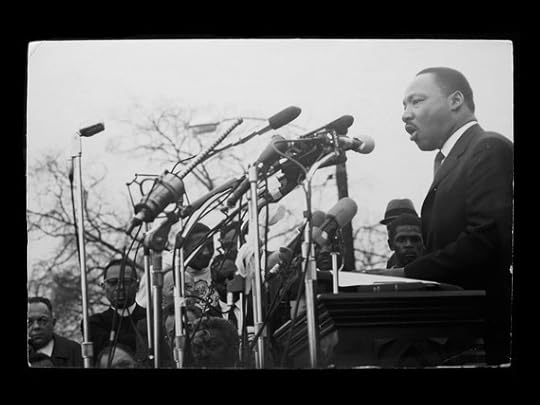
He followed the Civil Rights movement, capturing dramatic images of not just Dr Luther King but also protest marches in Montgomery and police lines in Alabama.
He was also present for some of the Sunset Boulevard marches in 1967 when local residents clashed with police on strict curfews that had been introduced which many saw as an infringement of civil rights.
When asked about his photographs, Hopper said, "I wanted to document something. I wanted to leave something that I thought would be a record of it, whether it was Martin Luther King, the hippies, or whether it was the artist."
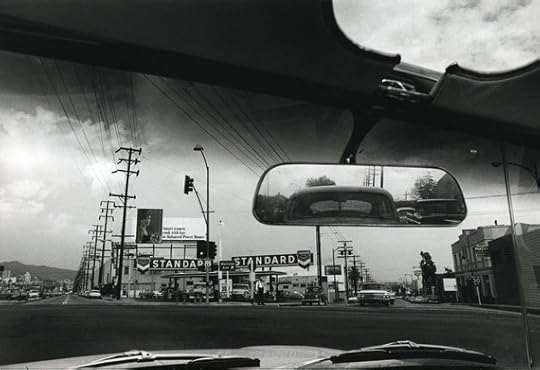
Dennis Hopper quit photography rather abruptly in 1967, just as he began work on Easy Rider, a decision that is hard to understand given his evident passion for it. Perhaps he simply replaced one creative outlet with another.
But though the photography was abandoned, Easy Rider (1969) runs on loop within the exhibition, along with The Last Movie (1970) and it's interesting to see how the style and energy of his photos made its way into these moving images.
It's sad Hopper didn't continue with his photography but nevertheless this library of emotive, passionate and intimate photos is a bittersweet reminder of both his talents and a unique period of profound change in American society.
Royal Academy of Arts, London to October 19, 2014
Image Credits:
1. Dennis Hopper Irving Blum and Peggy Moffitt, 1964 Photograph, 16.69 x 24.92 cm The Hopper Art Trust © Dennis Hopper, courtesy The Hopper Art Trust. www.dennishopper.com
2. Dennis Hopper Jane Fonda and Roger Vadim at Their Wedding in Las Vegas, 1965 Photograph, 17.02 x 24.87 cm The Hopper Art Trust © Dennis Hopper, courtesy The Hopper Art Trust. www.dennishopper.com
3. Dennis Hopper Martin Luther King, Jr., 1965 Photograph, 23.37 x 34.29 cm The Hopper Art Trust © Dennis Hopper, courtesy The Hopper Art Trust. www.dennishopper.com
4. Dennis Hopper Double Standard, 1961 Photograph, 17.45 x 24.87 cm The Hopper Art Trust © Dennis Hopper, courtesy The Hopper Art Trust. www.dennishopper.com
Victoria's debut novel Banking on Burlesque now available on Amazon.
Published on July 05, 2014 13:43
July 1, 2014
National Theatre Takes on Murdoch and Phone Hacking in New Play
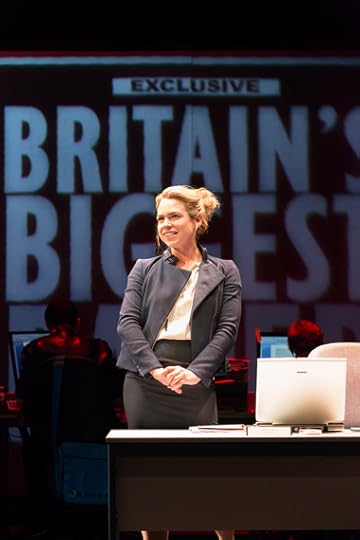
In pop culture terminology, the National Theatre has done a bit of a Beyoncé.
Conceived and rehearsed in secret, Great Britain, a play about phone hacking at a British tabloid, was suddenly announced last week and then on Monday, just days after the hacking trial verdicts were passed down, the show opened.
The quick opening, as well the bold decision to abandon the well-worn path of drawn-out run-up times and preview nights, meant there was a real buzz in the auditorium on opening night.
And that ballsy attitude runs right the way through this funny, bitingly satirical show as subtlety is thrown out the window as director Nicholas Hytner and writer Richard Bean go for Murdoch Inc. all guns blazing.
Everything we now know about tabloids, from the hacking trials and elsewhere, is crammed into this play's three hour running time - hacking phones of missing girls, Murdoch's expansion from print into television, philandering celebs, MPs expenses, corruption at the Met, mob attacks on paediatricians (rather than paedophiles) the coverage of a dying celeb (with echoes of Jade Goody), Saville, Murdoch's appearance at the Commons' Select Committee, former editors being leveraged into positions in government, 'fake Sheikhs', rummaging through bins, use of private detectives, paying out informers in bundles of cash, Page 3 girls, politicians' genuflections to the whims of media moguls, policy shaped by party donations...
There's a lot to take in.
It's comprehensive but probably too much. At times the desire to cover absolutely everything causes the story to suffer. The writing is exciting, packed full of one-liners but it's as if Bean and Hytner are trying to show how much they took in from the hacking trial, when a more selective approach would've made the piece more incisive. In this case, less would have been more.
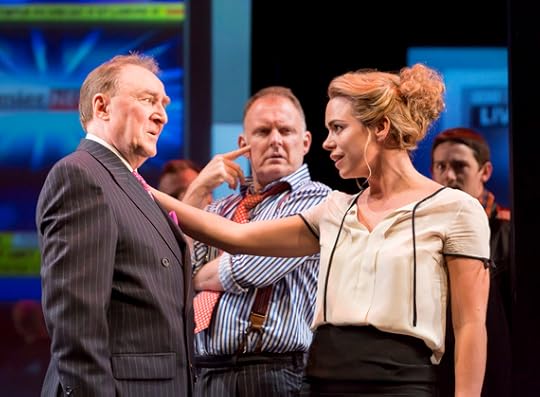
The cast is huge (there are over 30 speaking parts) but each of them is superb. Many are working with very one-dimensional stereotypes but in this farcical comedy set-up, it all works quite well.
Billie Piper shines as Paige Britain, the ambitious news editor at red-top British tabloid The Free Press where the mission statement of "we go out and destroy other people's lives on your behalf" pretty much sums up where we're expected to place our sympathies.
And with its focus on "scum stories" such as MEPs, immigrants, gypsies, feminists, benefit scroungers, single mothers, career women and "scousers, obviously" it's not particularly hard to guess which paper this is based on.
A cursory attempt is made to frame phone hacking in an ambiguous light - honourable when used to solve crimes; reprehensible when used for manipulation of politicians and innocent bystanders - but it's not really believable.
When Britain declares that had phone hacking found the missing schoolgirls alive she'd have been declared a hero, the sharp intake of breath in the auditorium was audible. It feels more like the character is self-deluded rather than making a fair point.
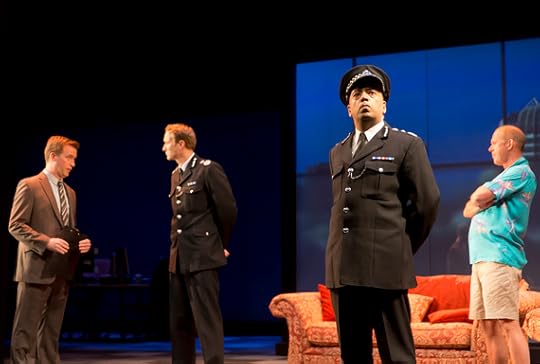
Nevertheless Piper is excellent and works well to lead the play from the front and balance out Paige's ruthless ambition and profound moral ambiguity with plenty of charm and some nice comic touches.
But the show is very much stolen by Aaron Neil as the hapless Police Commissioner who blunders from one PR disaster to another. I don't think I have laughed at anything as much this year as I have at Aaron Neil's comic timing and po-faced sincerity. His performance is so funny that even Oliver Chris, who plays Neil's ambitious Assistant Commissioner, struggled to keep a straight face.
As much as the talented cast, the dynamic production design (Tim Hatley and 59 Productions) impressively maintains the pace of the production throughout.
Huge screens shift across the stage, shaping the layout from newsrooms to yachts, from basement archives to The Ivy restaurant. But there's no let-up in the show to allow for these quick scenery changes. Instead key developments such as Breaking News clips and the Queen's Speech are projected on to the screens as they move across the darkened stage - a great reminder that we live in the era of 24-hour news coverage.
That this really great play was conceived and executed so quickly, which it needed to be to retain its topicality as well as bringing excitement and a dynamic buzz to theatre, is a compliment to all involved. But given that speed it was always likely to be a bit rough around the edges.
In many ways that imperfection, that need to just get it out there irrelevant of any small gripes, reflects life at the tabloids. I liked the raw edge. I liked the imperfections. Longer development time and preview nights would probably have polished the edges but somehow I think that would have defeated the purpose and robbed Great Britain of its energy and relevance.
National Theatre, London to August 23, 2014
Images © Johan Persson
1. BILLIE PIPER as Paige Britain
2. Left to right: DERMOT CROWLEY as Paschal O'Leary, ROBERT GLENISTER as Wilson Tikkel, BILLIE PIPER as Paige Britain
3. AARON NEIL (Sully Kassam) with JOSEPH WILKINS, OLIVER CHRIS and ANDREW WOODALL.
Victoria's debut novel Banking on Burlesque now available on Amazon.
Published on July 01, 2014 11:52
June 27, 2014
So Lindsay Lohan Is Coming to the West End...
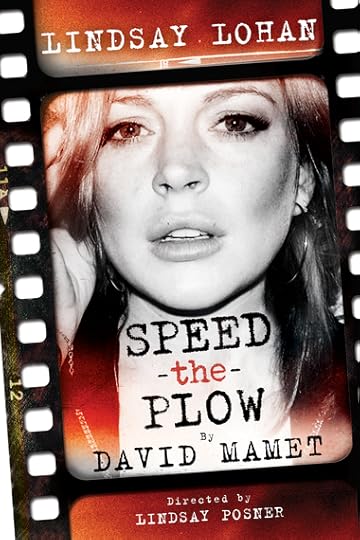
It's been a week of surprises in theatreland.
Following hot-on-the-heels of the National's announcement for Great Britain, a play about phone-hacking that had been rehearsed on the sly, came the announcement from Theatre Royal Bath Productions that this Autumn they are reviving David Mamet's satire on Hollywood Speed the Plow and casting Lindsay Lohan.
But unlike the announcement from the NT, this was not greeted with excitement but with trepidation for Lindsay Lohan's reputation is more linked with that of troubled star rather than acting professional.
Director Lindsay Posner didn't exactly allay fears either with his comments that he will "cast to the hilt" around Lohan, a comment that has been interpreted that perhaps the box-office draw will need propping up in some way.
It's sad that it has come to this though as Lindsay Lohan really did have great potential. She was more than just a competent actress when she was young. She was bright, sparky and showed plenty of signs that she would make that transition from child star to adult actress with ease.
But it wasn't to be. Instead, with addiction issues, family break-ups, courtroom dramas and stints in rehab, she has become tabloid fodder, more likely to make headlines for her ongoing feud with Paris Hilton rather than critical acclaim for acting performances.
I am on Lindsay Lohan's side. I really do want her to succeed. But plenty feel that way and many have tried to give Lindsay another chance only to find themselves left high and dry.
The most recent attempt was earlier this year from the Queen herself - Oprah. She commissioned a reality TV show that would follow Lindsay as she tried to settle down and rebuild her life in New York.
The result was a disaster. Lindsay couldn't even do three days in a row let alone three months. She was routinely late or a no-show. Exasperated, Oprah herself tried to intervene, offering Lindsay the alternative of just dropping the show.
Lindsay, as desperate for money as she was work, promised to commit. But she was just unable to do this and the show was cancelled.
And that was just a couple of months ago.
And that was a reality TV show. A three-month theatrical run is a completely different proposition. The schedule cannot revolve around Lindsay's issues - the commitment is to the schedule and to the audience to ensure that a high-quality production is delivered night after night after night.
The sweepstakes have already started. How many performances will Lindsay actually make? Will the show even complete its run?
And the questions are already there - if Lindsay is the big draw, will there be refunds for the nights if/when she doesn't show?
It's a big risk for any production company to take on Lindsay Lohan. And part of me fears the cash cow element to this - that Lohan has been hired for the money, for the curiosity factor, just to sell tickets.
Certainly that is backed up by the eye-watering ticket prices. Tickets START at £25 and go all the way up to £125 for premium seats. £125. Just to put that in perspective, that's twice what it cost me to see Kevin Spacey in Clarence Darrow. And I was in the third row at the Old Vic for that. In fact, thinking about it now, I saw Kevin Spacey in Speed the Plow for less than that.
For £25 you get restricted leg room up in the Gods. But even the ticket prices in-between are not desirable. £50 and you can get restricted view in the Dress Circle. If you just want to be able to SEE the show in some relative comfort, your cheapest ticket price is £60.
£60. To see someone who may or may not appear.
In my opinion, not only does this therefore make it obvious this is a money-grab (Speed the Plow should not an expensive play to produce) but it heaps the pressure on Lindsay even more. It raises the stakes, the repercussions, of a non-appearance.
I want this to work, I really do. But I have my doubts. There are no signs that Lindsay Lohan is actually able to withstand the rigours of a West-End run, let alone one that will be scrutinised by the UK's press. I fear that the pressure could just be too much.
Poster Image © Theatre Royal Bath Productions
Victoria's debut novel Banking on Burlesque is available now on Amazon.
Published on June 27, 2014 04:32
June 26, 2014
The Valley of Astonishment: The Mystery of the Human Brain Explored
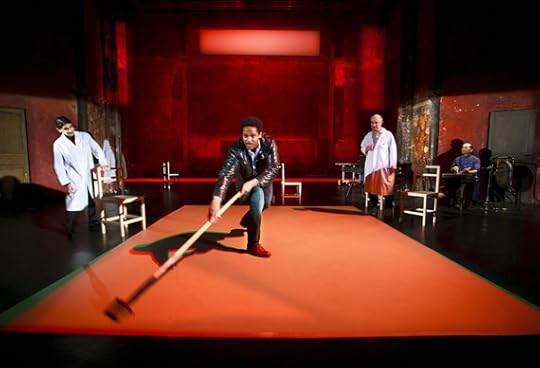
The Valley of Astonishment at the Young Vic is a play about synaesthesia. Sounds dry but actually it is warm, engaging, smart and funny.
Synaesthesia is where the brain blends the senses so memory becomes linked with colour and form. It's a condition that means many of those with it exhibit astonishing skills such as profound abilities to memorise names and telephone numbers, perform complex mental arithmetic at the snap of a finger, as well as demonstrating talents for more creative activities such as visual art and music.
The heart and soul of this show is the story of Sammy Costas (played beautifully by Kathryn Hunter), a woman working at a newspaper whose ability to memorise numerical and word sequences results in her being sent for tests at a neurological institute.
Through Sammy and the characters she meets along the way, we get to witness the joys and trials of this extraordinary condition. Whether it's Jared McNeill explaining the wonder of capturing the sounds of Miles Davis and John Coltrane in paintings, or Marcello Magni bringing a comedic touch with his depictions of a one-armed card shark or a man who has overcome much of his paralysis through retraining of his mind, you are left in awe at the wonders of the human brain.
I didn't imagine that this show could be as entertaining as it was. The directors Peter Brook and Marie-Hélène Estienne have got the balance of science with entertainment just about right. Just when you thought the production was teetering on the edge of becoming too dry, there'd be a moment of humour, or the fourth wall would come down and we were reengaged again.
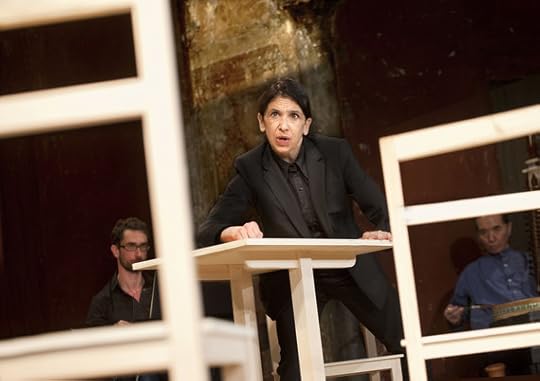
Actually the level of audience interaction in this show was a shrewd move. When you're trying to bring science to life it works so much better when the audience is more a participant than an observer. It was also the source of many of the lighter moments in the show and made this a real experience that'll get you thinking about what you've seen long after you've left the theatre.
Though this show is on the main stage at the Young Vic, it is, in truth, quite a small production. The cast involves just three actors - all of whom were immensely talented and engaging - and who play a range of characters with ease.
The support of two musicians lends some depth to the production but the set is sparse, comprising a couple of wooden chairs and a table. If you're looking for big production numbers, you won't find them here. Instead this bare set is used as juxtaposition to the vivid worlds conjured up in the minds of those characters with this extraordinary condition.
With its sparse set design, lack of big names and science-y subject matter, this play won't appeal to everyone, which is a shame as the audience were enraptured the night I went, giving the cast and musicians big cheers at their curtain call.
Young Vic Theatre, London to July 12, 2014
Image credits © Simon Annand
Victoria's debut novel Banking on Burlesque is now available on Amazon.
Published on June 26, 2014 11:51
June 23, 2014
Summer Exhibition 2014, Royal Academy of Arts
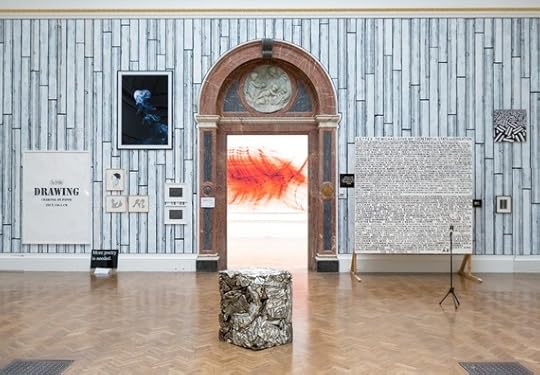
Practically a national institution, the annual Summer Exhibition at the Royal Academy of Arts is the world's largest open entry exhibition, which showcases new and recent art from emerging artists to the biggest names in contemporary art and architecture.
I've been critical of the Summer Exhibition in the past but this year's show is a revelation. Previously the galleries have felt a bit chaotic, with the quality of art on show a bit hit-and-miss, but not so this year. Evidently great care and thought has been put into the hanging and each room is full of high-quality pieces.
Each room has been hung by a single Academician with a different theme in mind. As a result, the rooms seem more coherent, making it easier to absorb the artwork.
Two rooms that are a great compare and contrast are Rooms II and the Lecture Room. The former, hung by Hughie O'Donoghue has its focus on paintings in elemental states, emphasising constituents of colour, form and material. This room is dominated by large canvases dominated with bold colours.
Whereas the Lecture Room, hung by Cornelia Parker, is themed in black and white. Cornelia Parker wanted the pieces here to investigate monochrome, as a deliberate juxtaposition to the riot of colour that is the traditional style of the Summer Exhibition. The room works perfectly as the intended visual firebreak.
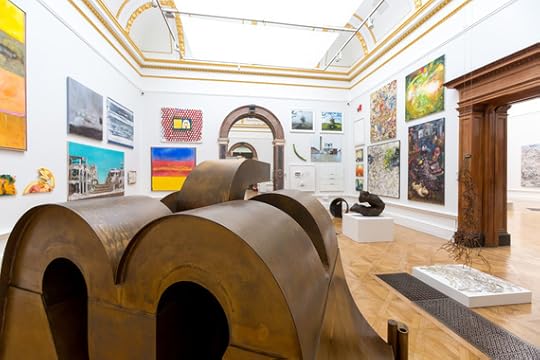
Maybe it's the impact of having 15 new Royal Academicians appointed this year as this year's show is really fresh and dynamic. I can't ever remember the Architecture room embracing punk but this year the voice of John Lydon bounces off the walls as one of the works in this room is a film with soundtrack courtesy of Public Image Ltd. - Two Nuns by Ron Arad. The times, they are a changing!
Of course the great attraction, the unique aspect to the Summer Exhibition, is its democracy. Any artist can submit work to the Royal Academy for consideration and the resulting array of works that pass that test still cram the walls of many of the rooms.
There's something wonderful about being overwhelmed by the walls where there's not a spare inch to be found, every bit covered by a piece of work that has made an artist's dream come true. Only thankfully with the walls themed e.g. portraiture, it's easier for the eye to wander across the paintings and take them all in.
There are some great pieces on show. Plenty of visitors were hovering around Una Stubbs' watercolours of Benedict Cumberbatch and Martin Freeman but just above these headline-grabbers is Two People by Barbara Sykes, which won the Hugh Casson Drawing Prize.
It's a beautiful drawing. I wanted to tell all the fans looking at Stubbs' watercolours, 'look up! Look up!' But I think they were more focused on taking surreptitious snaps of the Sherlock stars with their iPhones. Shame.
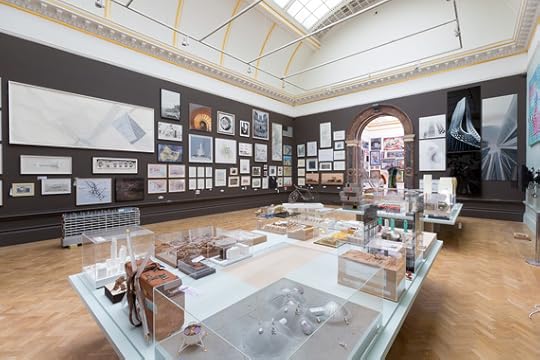
Of course, being such a loved tradition, the Summer Exhibition attracts a diverse audience and I always enjoy observing which art catches people's attention.
I was pleased that so many paused in front of more abstract work such as Anselm Kiefer's Kranke Kunst. He is such an important artist and the subject of a dedicated exhibition later this year at the RA.
And many seemed quite moved by Sean Scully's Doric Night, a collection of rectangular oil on aluminium shapes in various shades of black. A very dark piece that was hung well, a great juxtaposition to the colours that surround it.
But of course not all of the art will appeal to everyone - the intention is that hopefully you will find some that speak to you - and I did hear a few comments along the lines of "I mean, where would you put that brown jobby?"
To be expected, I suppose. But there were also some interesting assumptions about the artists, such as "oh look, there's always the woman who does the liquorice allsorts" - a reference to Allsorts (Double Square) painted by, ahem, Robert Dukes.
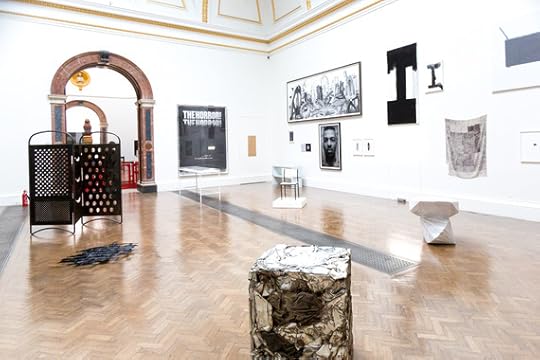
The winner of the Charles Wollaston award this year - the award for the most distinguished work in the exhibition - went to Wolfgang Tillmans Greifbar 1. A huge inkjet print of what seemed like a red fluid flowing out into clear liquid. Some thought it was like blood in water. It is such a distinctive piece and is the dominant piece of the exhibition in that you can see it at the far end of the gallery as soon as you walk in. It is a worthy winner.
The Summer Exhibition is always popular but getting people to stay and take their time to really look at the pieces can be a bit of a challenge so credit to the RA for introducing a Pimms bar in the galleries with a smattering of tables and chairs to allow visitors to take a breather.
Sadly but inevitably I left the Exhibition without any original art to my name. I just about managed to scrape the pennies together to buy the exhibition catalogue. How I longed to take home one of the romantic Bill Jacklin paintings or the glorious Indian Festival on the Ganges by Anthony Eyton which reflected the sensory overload of this festival perfectly.
These paintings though were in the thousands but as an impoverished writer I didn't even have the pennies to buy one of the more affordable Tracey Emin sketches (her erotic Away From It All was wonderful), But at £375 these had all long gone anyway.
One day, Victoria, one day. Perhaps I'll have to settle for going one better and pick up the paints and pencils and submit one of my own masterpieces instead.
But don't hold me to that!
Royal Academy of Arts, London to August 17, 2014
Image credits: Installation views of Royal Academy Summer Exhibition 2014 © Benedict Johnson
Victoria's debut novel Banking on Burlesque is available now.
Published on June 23, 2014 11:51
June 18, 2014
Lana Del Rey's Ultraviolence Is Dark, Yes, But Wonderfully So
Lana Del Rey's new album may superficially seem like more of the same. Certainly Del Rey has picked up where she left off on Born to Die. Her haunting, raspy vocals are still there, as are the depressing lyrics of a disillusioned woman looking for a life she craves on the wrong side of the tracks.
But actually Ultraviolence sees Del Rey abandon all pretence of pop-friendly tracks and embrace a far more menacing, darker atmosphere and lyrics. Where Born to Die saw Lana Del Rey both ambivalent and confused about what she wanted from life, Ultraviolence sees her state clearly the life she wants - and accepting of the consequences that will come of it.
Wikipedia classifies Del Rey as "dream pop," no doubt trying to convey the slow music tempo and dreamy, raspy vocals. But here on Ultraviolence that dream is more like a nightmare as Lana Del Rey lets the darkness overcome her.
Track One: Cruel World
This track sets the tone for the album perfectly. Over a slow thumping beat, Lana dances on the grave of a dead relationship. "I shared my body and mind with you / that's all over now/ I did what I had to do / I found another anyhow." Ouch. Lana is a cruel woman at the centre of her own cruel world.
Track Two: Ultraviolence
The title track is about a violent abusive relationship with Lana even repeating the controversial The Crystals' lyric "he hit me and it felt like a kiss" for good measure. But this abuse isn't packaged up as a catchy pop song, this is a very dramatic production.
The subject matter makes you wince but this is an extremely well produced song. The way Del Rey offsets "I can hear violins" with "I can hear sirens" is smart as well as tragic.
Track Three: Shades of Cool
A sad, slow song about being in love with an emotionally unavailable man. Not an unusual theme for Lana Del Rey but what's interesting is the bite in the lyric towards her competition. "And when he calls/he calls for me and not for you."
And that really is the marked change in this album's lyrics from Born to Die. On Ultraviolence, there's no interest in courting sympathy.
Track Four: Brooklyn Baby
The current single release from the album, though this is a very catchy song, this isn't my favourite. I found the lyrics a bit contrived, such as "I've got feathers in my hair / I get down to beat poetry."
This is the closest thing this album has to a pop track and, interestingly, as a result it almost doesn't seem to belong with the rest of the tracks. Yet it is a song I've been humming ever since I heard it so Lana must've known what she was doing when she kept this on the track list.
Track Five: West Coast
One of the best songs on the album sees Lana Del Rey revisit a familiar subject - the glamour of Hollywood and their starlets. And how much she wants that too. The song has a sinister atmosphere as Del Rey sings low in her register "Down on the West Coast they got a sayin' / if you're not drinkin' then you're not playin'" over drums and the strumming of a lone electric guitar.
Track Six: Sad Girl
The opening lyric "Being a mistress on the side/ it might not appeal to fools like you" shows Lana unrepentant for her taking of married men - and it's pretty clear what she thinks of women who judge her. No wonder feminism doesn't interest her!
Reminiscent of Portishead in its production, this would stand out if the other tracks were more varied. As they're not, this does fade into the background a bit.
Track Seven: Pretty When You Cry
As does this track too. A maudlin tale of a woman loving a man who loves his drugs more than her. A pretty enough track that suits the mood of the album perfectly though it doesn't stand out as an individual piece.
Track Eight: Money Power Glory
Luckily the string of tracks you'll probably skip is broken here with a run of some amazing tracks. Sung almost as a hymn, Money Power Glory sees Lana abandoning God for her lust of fame. Unapologetic and deliberate, the defeated hum-drum existence of Video Games is replaced with explicit ambition. "I want money and all your power, all your glory/ Hallelujah, I wanna take you for all that you got."
This is a mission statement presented with no shame. One of the stand-out tracks on the album.
Track Nine: Fucked My Way Up to the Top
And Lana continues on without remorse. The title of the track says it all. The doe-eyed pity-me sentiment of the girl-next-door in This is What Makes Us Girls is gone. Yes, the song declares, she may have fucked her way to the top but when Lana spits out "This is my show" we are under no illusions about who's in control.
She's hard, heartless and she doesn't care whether you love her or hate her as she's now her own best cheerleader. "Go, Baby Go, Go! Go! Go! Go! Go" she sings out. An amazing track.
Track Ten: Old Money
The previous two tracks had seen the pace pick up a little but here it returns to its almost tranquillised state. But don't be tempted to skip the track as though this is very slow, it's a beautiful, wistful and bittersweet song about lost youth. "Those summer nights seem long ago/ And so is the girl you used to call/ The Queen of New York City."
This is a song that shows the crack in the cool exterior and plucks the heartstrings.
Track Eleven: The Other Woman
This is the closing track on the standard version of the album and it's an interesting ending point as, much like Old Money, this is a poignantly sad song. For you see, the other woman in the song - the mistress - is Lana.
All the defiance of the other tracks is set aside and what is left is profound loneliness and vulnerability. "The other woman will never have his love to keep / And as the years go by the other woman / Will spend her life alone." It's a song that sees Lana (character or artist?) reconciling herself to the repercussions of the life she has chosen.
Track Twelve: Black Beauty
Setting aside the (no doubt, deliberate) double-meaning for drugs, the black beauty in this song refers to the black cloud of depression and self-destruction that looms over Lana's lover. "You have no room for light / Love is lost on you." It's a lovely little song but not one of the most memorable moments on an album that has a lot of this sentiment.
Track Thirteen: Guns and Roses
I can't help feeling this title plays a little on Lana's fling with Axl Rose but, like Black Beauty, there's not much more to this song than it's title's double meaning. Its maudlin sentiment fits with the album but you can see how this is a bonus track rather than on the main album. There are more memorable songs elsewhere.
Track Fourteen: Florida Kilos
Now this song stands out a mile because, with its calypso sway and summer sound, this track sounds almost, well, happy, which probably explains why it's a bonus track.
This is a great song but I don't think this means you'll be hearing this on the radio. Lyrics such as "White lines, pretty daddy, go ski it / You snort it like a champ, like the winter we're not in" means it's unlikely to make the Radio 1 approved playlist anytime soon. Already on my summer playlist though.
Track Fifteen: Is This Happiness
But the smiles don't last and instead the album closes with an intriguing question from Lana to herself - "Is this happiness?" A question she asks again and again over a piano accompaniment. You're left with the impression that Lana knows there is no happy ending at the end of a life lived like this. One can only hope there is a lot of character rather than biography in these lyrics.
Overall:
Far darker than Born to Die, Ultraviolence is not a conventional pop album. At times the pace of the album is so slow it feels as if you're being sedated. Only a couple of the tracks even brush mid-tempo. But combined with these angry lyrics of alienation, self-deceit and dark ambition, it makes for an intriguing change in a pop market saturated with instantly disposable pop songs.
Vocally and lyrically, it's also an accomplished piece of work that sees Lana Del Rey really develop her profound talents.
In comparison with her peers, Lana Del Rey stands out a mile. She's not looking for empathy or a group hug. At times on Ultraviolence it seems Lana really wants you to hate her. It's a very defiant unapologetic album. And not a single radio-friendly track to be heard.
It's brave, intense and I love it.
Note: Track listing above is for the iTunes bonus tracks version.
But actually Ultraviolence sees Del Rey abandon all pretence of pop-friendly tracks and embrace a far more menacing, darker atmosphere and lyrics. Where Born to Die saw Lana Del Rey both ambivalent and confused about what she wanted from life, Ultraviolence sees her state clearly the life she wants - and accepting of the consequences that will come of it.
Wikipedia classifies Del Rey as "dream pop," no doubt trying to convey the slow music tempo and dreamy, raspy vocals. But here on Ultraviolence that dream is more like a nightmare as Lana Del Rey lets the darkness overcome her.
Track One: Cruel World
This track sets the tone for the album perfectly. Over a slow thumping beat, Lana dances on the grave of a dead relationship. "I shared my body and mind with you / that's all over now/ I did what I had to do / I found another anyhow." Ouch. Lana is a cruel woman at the centre of her own cruel world.
Track Two: Ultraviolence
The title track is about a violent abusive relationship with Lana even repeating the controversial The Crystals' lyric "he hit me and it felt like a kiss" for good measure. But this abuse isn't packaged up as a catchy pop song, this is a very dramatic production.
The subject matter makes you wince but this is an extremely well produced song. The way Del Rey offsets "I can hear violins" with "I can hear sirens" is smart as well as tragic.
Track Three: Shades of Cool
A sad, slow song about being in love with an emotionally unavailable man. Not an unusual theme for Lana Del Rey but what's interesting is the bite in the lyric towards her competition. "And when he calls/he calls for me and not for you."
And that really is the marked change in this album's lyrics from Born to Die. On Ultraviolence, there's no interest in courting sympathy.
Track Four: Brooklyn Baby
The current single release from the album, though this is a very catchy song, this isn't my favourite. I found the lyrics a bit contrived, such as "I've got feathers in my hair / I get down to beat poetry."
This is the closest thing this album has to a pop track and, interestingly, as a result it almost doesn't seem to belong with the rest of the tracks. Yet it is a song I've been humming ever since I heard it so Lana must've known what she was doing when she kept this on the track list.
Track Five: West Coast
One of the best songs on the album sees Lana Del Rey revisit a familiar subject - the glamour of Hollywood and their starlets. And how much she wants that too. The song has a sinister atmosphere as Del Rey sings low in her register "Down on the West Coast they got a sayin' / if you're not drinkin' then you're not playin'" over drums and the strumming of a lone electric guitar.
Track Six: Sad Girl
The opening lyric "Being a mistress on the side/ it might not appeal to fools like you" shows Lana unrepentant for her taking of married men - and it's pretty clear what she thinks of women who judge her. No wonder feminism doesn't interest her!
Reminiscent of Portishead in its production, this would stand out if the other tracks were more varied. As they're not, this does fade into the background a bit.
Track Seven: Pretty When You Cry
As does this track too. A maudlin tale of a woman loving a man who loves his drugs more than her. A pretty enough track that suits the mood of the album perfectly though it doesn't stand out as an individual piece.
Track Eight: Money Power Glory
Luckily the string of tracks you'll probably skip is broken here with a run of some amazing tracks. Sung almost as a hymn, Money Power Glory sees Lana abandoning God for her lust of fame. Unapologetic and deliberate, the defeated hum-drum existence of Video Games is replaced with explicit ambition. "I want money and all your power, all your glory/ Hallelujah, I wanna take you for all that you got."
This is a mission statement presented with no shame. One of the stand-out tracks on the album.
Track Nine: Fucked My Way Up to the Top
And Lana continues on without remorse. The title of the track says it all. The doe-eyed pity-me sentiment of the girl-next-door in This is What Makes Us Girls is gone. Yes, the song declares, she may have fucked her way to the top but when Lana spits out "This is my show" we are under no illusions about who's in control.
She's hard, heartless and she doesn't care whether you love her or hate her as she's now her own best cheerleader. "Go, Baby Go, Go! Go! Go! Go! Go" she sings out. An amazing track.
Track Ten: Old Money
The previous two tracks had seen the pace pick up a little but here it returns to its almost tranquillised state. But don't be tempted to skip the track as though this is very slow, it's a beautiful, wistful and bittersweet song about lost youth. "Those summer nights seem long ago/ And so is the girl you used to call/ The Queen of New York City."
This is a song that shows the crack in the cool exterior and plucks the heartstrings.
Track Eleven: The Other Woman
This is the closing track on the standard version of the album and it's an interesting ending point as, much like Old Money, this is a poignantly sad song. For you see, the other woman in the song - the mistress - is Lana.
All the defiance of the other tracks is set aside and what is left is profound loneliness and vulnerability. "The other woman will never have his love to keep / And as the years go by the other woman / Will spend her life alone." It's a song that sees Lana (character or artist?) reconciling herself to the repercussions of the life she has chosen.
Track Twelve: Black Beauty
Setting aside the (no doubt, deliberate) double-meaning for drugs, the black beauty in this song refers to the black cloud of depression and self-destruction that looms over Lana's lover. "You have no room for light / Love is lost on you." It's a lovely little song but not one of the most memorable moments on an album that has a lot of this sentiment.
Track Thirteen: Guns and Roses
I can't help feeling this title plays a little on Lana's fling with Axl Rose but, like Black Beauty, there's not much more to this song than it's title's double meaning. Its maudlin sentiment fits with the album but you can see how this is a bonus track rather than on the main album. There are more memorable songs elsewhere.
Track Fourteen: Florida Kilos
Now this song stands out a mile because, with its calypso sway and summer sound, this track sounds almost, well, happy, which probably explains why it's a bonus track.
This is a great song but I don't think this means you'll be hearing this on the radio. Lyrics such as "White lines, pretty daddy, go ski it / You snort it like a champ, like the winter we're not in" means it's unlikely to make the Radio 1 approved playlist anytime soon. Already on my summer playlist though.
Track Fifteen: Is This Happiness
But the smiles don't last and instead the album closes with an intriguing question from Lana to herself - "Is this happiness?" A question she asks again and again over a piano accompaniment. You're left with the impression that Lana knows there is no happy ending at the end of a life lived like this. One can only hope there is a lot of character rather than biography in these lyrics.
Overall:
Far darker than Born to Die, Ultraviolence is not a conventional pop album. At times the pace of the album is so slow it feels as if you're being sedated. Only a couple of the tracks even brush mid-tempo. But combined with these angry lyrics of alienation, self-deceit and dark ambition, it makes for an intriguing change in a pop market saturated with instantly disposable pop songs.
Vocally and lyrically, it's also an accomplished piece of work that sees Lana Del Rey really develop her profound talents.
In comparison with her peers, Lana Del Rey stands out a mile. She's not looking for empathy or a group hug. At times on Ultraviolence it seems Lana really wants you to hate her. It's a very defiant unapologetic album. And not a single radio-friendly track to be heard.
It's brave, intense and I love it.
Note: Track listing above is for the iTunes bonus tracks version.
Published on June 18, 2014 15:30



